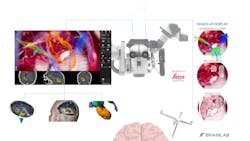Microscopy system harnesses virtual reality technology for image-guided neurosurgery
In July 2016, Leica Microsystems (Wetzlar, Germany) introduced its CaptiView microscope image injection system, which overlays critical virtual reality imaging directly onto the brain when viewed through the eyepiece (ocular) during surgery.
Related: 'Heads-up' 3D-enabled retinal surgery broadcast live
The heads-up display system, which uses Cranial 3.1 navigation software from Brainlab (Feldkirchen, Germany) and a Leica M530 OH6 microscope, provides neurovascular and fiber-track information in 2D or 3D as well as on-screen video overlays visible through the eyepiece. The microscope integration also allows the surgeon to switch views in the eyepiece, toggling between live and pre-operative anatomical images using handle control buttons or footswitch. Markers attached to the microscope enable positional tracking and autofocus.
The technology allows images of chosen objects, including original computed tomography (CT), magnetic resonance imaging (MRI), and angiogram datasets, to be superimposed directly into the neurosurgeon's eyepiece during microscopic surgery. Joshua Bederson, MD, professor and system chair for the Department of Neurosurgery at Mount Sinai Health System (New York, NY), is the first neurosurgeon to use the surgical navigation tool, and worked closely with the two companies to develop it.
This new technology will be used alongside the Surgical Navigation Advanced Platform (SNAP) developed by Surgical Theater, LLC (Mayfield, OH), which is a standard feature in the operating room. SNAP provides advanced 3D visualization technology that gives surgeons an intraoperative and patient-specific 3D environment to plan and understand surgical approaches.
Bederson is an expert in skull-base and cerebrovascular surgery and has performed more than 3600 neurosurgical operations at Mount Sinai. He owns equity in Surgical Theater, LLC.
For more information, please visit www.leica-microsystems.com and www.mountsinai.org.
